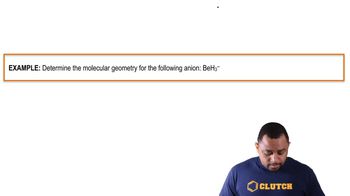The hypochlorite ion, ClO-, is the active ingredient in bleach. The perchlorate ion, ClO4-, is a main component of rocket propellants. Draw Lewis structures for both ions. (c) What is the oxidation number of Cl in the hypochlorite ion? (d) What is the oxidation number of Cl in the perchlorate ion, assuming the Cl—O bonds are all single bonds?
(a) The nitrate ion, NO3^-, has a trigonal planar structure with the N atom as the central atom. Draw the Lewis structure(s) for the nitrate ion.
 Verified step by step guidance
Verified step by step guidanceKey Concepts
Lewis Structures

Trigonal Planar Geometry

Resonance Structures

The following three Lewis structures can be drawn for N2O:
(a) Using formal charges, which of these three resonance forms is likely to be the most important?
The following three Lewis structures can be drawn for N2O:
(b) The N—N bond length in N2O is 1.12 Å, slightly longer than a typical N≡N bond; and the N—O bond length is 1.19 Å, slightly shorter than a typical N═O bond (see Table 8.4). Based on these data, which resonance structure best represents N2O?
Ortho-Dichlorobenzene, C6H4Cl2, is obtained when two of the adjacent hydrogen atoms in benzene are replaced with Cl atoms. A skeleton of the molecule is shown here. (a) Complete a Lewis structure for the molecule using bonds and electron pairs as needed.
Ortho-Dichlorobenzene, C6H4Cl2, is obtained when two of the adjacent hydrogen atoms in benzene are replaced with Cl atoms. A skeleton of the molecule is shown here. (b) Are there any resonance structures for the molecule? If so, sketch them.
Consider the hypothetical molecule B-A=B. Are the following statements true or false? (a) This molecule cannot exist. (b) If resonance was important, the molecule would have identical A–B bond lengths.
